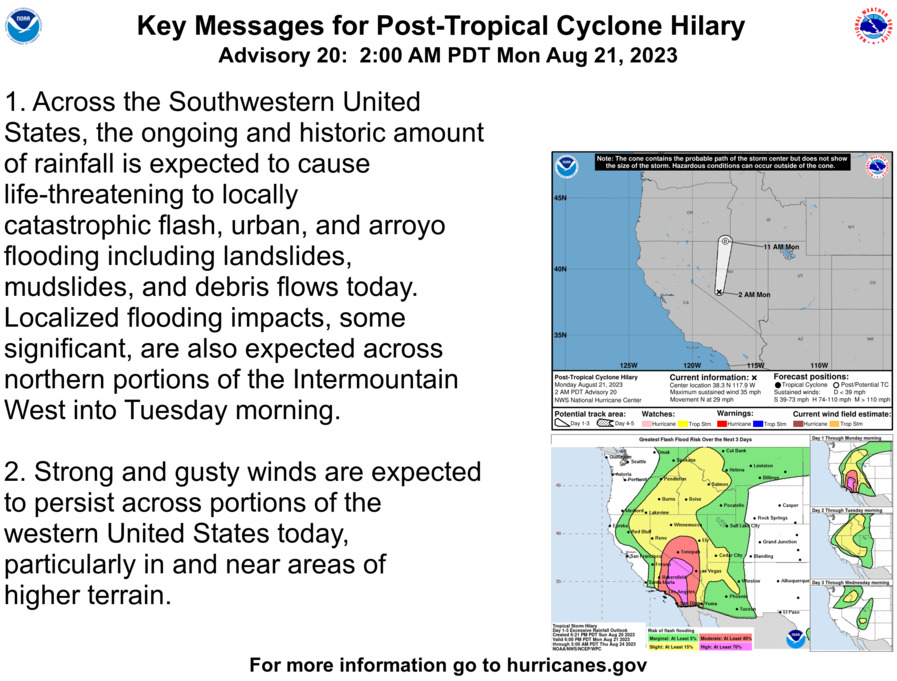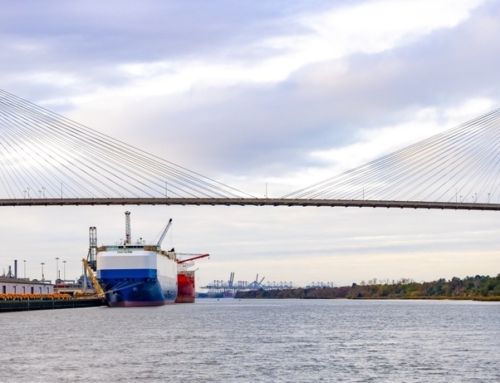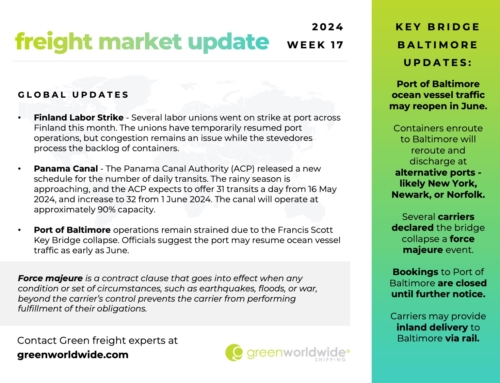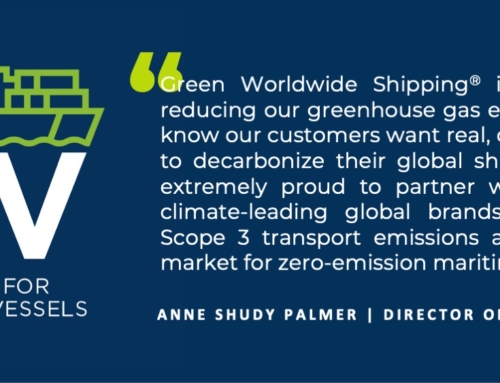MONDAY, AUGUST 23, 2023 STATUS UPDATES
Port of Los Angeles is operating commercial facilities (terminals, rail, lifts) under Heavy Weather Protocols.
No major infrastructure damages reported at the ports or rail and all costal warning were cancelled.
Post-Tropical Cyclone Hilary is still moving through the southwestern United States where flash flooding and strong winds remain a serious concern for parts of southern California, Nevada, Idaho, and Oregon.
Hurricane Hilary was downgraded to a tropical storm when it made landfall in southern California over the weekend.
Hurricane Hilary is growing in strength as it barrels towards the western coast of North America. Key ports in southern California are in the high-risk zone for heavy rains, strong winds, and flash floods resulting from the class 4 hurricane. The storm is expected to lose strength as it travels up the Baja Peninsula and should be downgraded to a tropical storm when it reaches Los Angeles.
The Ports of Los Angeles and Long Beach are bracing for the unprecedented weather system. Class 1 railroads are also preparing for the impacts of Hurricane Hilary, which may begin as early as Saturday morning, by staging rail ballast and panels to expedite a recovery effort in the event of an outage.
“As necessary and with the assistance of Los Angeles Port Pilots and the Marine Exchange of Southern California, vessels will be relocated to anchorage points offshore to ride the storm out. Los Angeles Port Police are prepared to work closely with our tenants, the U.S. Coast Guard L.A./Long Beach sector, and our other local law enforcement, maritime fire, and emergency management agency partners maintaining a readiness posture to respond to this potential climate emergency.”
Port of Los Angeles Statement
SUPPLY CHAIN IMPACT
Hurricanes are a rare occurrence in southern California. The winds, rain, and fast floods expected may impact the supply chain by limited port operations, damaging infrastructure, and creating shipping delays and supply shortages.
Port Operations: The Ports of Long Beach and Los Angeles are major gateways for goods coming into the southwestern United States. Hurricane Hilary has the potential to bring heavy rains, strong winds, and flash flooding to the region which could impact port operations.
Transportation Delays and Supply Shortages: The hurricane’s winds, rains, and flooding may cause infrastructure damage impacting the road and rail networks that connect Southern California’s ports to the rest of the country potentially impacting the movement of goods, leading to shortages and production slowdowns.
STRATEGIES FOR SHIPPERS
A range of options are available for businesses to mitigate disruptions to their supply chain should Hurricane Hilary impact freight movement.
- Collaboration and Partnership: Partner with a freight forwarding company that maintains a reliable and diverse carrier network. A freight forwarder will leverage relationships within its network to mitigate supply chain disruption by using alternate carriers, transportation modes, and trade routes.
- Warehousing and Inventory Control: A key strategy to mitigate shipping disruptions is utilizing warehousing and inventory management. Stockpiling inventory in a secure warehouse offers businesses a safety net to sustain operations during periods of uncertainty. Proximity to key markets and implementing agile inventory management practices can help optimize supply and demand fluctuations.
- Leverage Technology: Advancements in technology, including data analytics and real-time tracking systems, offer businesses enhanced visibility and efficiency in supply chain management. By leveraging these tools, companies can optimize processes, reduce bottlenecks, and respond quickly to supply chain changes. Businesses must be proactive to mitigate potential supply chain disruptions.
With the potential impact of Hurricane Hilary impacting the southwest United States, shipping delays due to the Panama Canal draft and booking restrictions, and constrained ocean carrier capacity, shippers should be evaluating their trade lanes, modes, and alternate shipping solutions to prevent disruptions in their supply chains.
In a season when supply chain disruptions grow more frequent, including those caused by natural disasters or climate change, companies that adopt these forward-thinking strategies will be better prepared to confront challenges head-on.
NEED HELP WITH SHIPMENTS?
Contact [email protected] to speak with Green’s freight experts.
Stay up-to-date on freight news with Green’s Weekly Freight Market Update by following us on Facebook, Instagram, and LinkedIn. For continuous updates, make sure to check out our website at greenworldwide.com.






